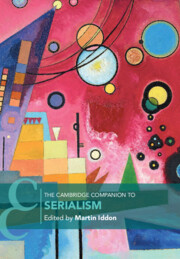
-
Select format
-
- Publisher:
- Cambridge University Press
- Publication date:
- March 2023
- February 2023
- ISBN:
- 9781108592116
- 9781108492522
- 9781108716864
- Dimensions:
- (244 x 170 mm)
- Weight & Pages:
- 0.97kg, 440 Pages
- Dimensions:
- (244 x 170 mm)
- Weight & Pages:
- 0.76kg, 440 Pages
- Collection:
- The Cambridge Companions to Music
- Series:
- Cambridge Companions to Music
You may already have access via personal or institutional login- Collection:
- The Cambridge Companions to Music
- Series:
- Cambridge Companions to Music
Book description
What is serialism? Defended by enthusiastic champions and decried by horrified detractors, serialism was central to twentieth-century art music, but riven, too, by inherent contradictions. The term can be a synonym for dodecaphony, Arnold Schoenberg's 'method of composing with twelve tones which are related only to one another'. It can be more expansive, describing ways of composing systematically with parameters beyond pitch - duration, dynamic, and more - and can even stand as a sort of antonym to dodecaphony: 'Schoenberg is Dead', as Pierre Boulez once insisted. Stretched to its limits, it can describe approaches where sound can be divided into discrete parameters and later recombined to generate the new, the unexpected, beginning to blur into a further antonym, post-serialism. This Companion introduces and embraces serialism in all its dimensions and contradictions, from Schoenberg and Stravinsky to Stockhausen and Babbitt, and explores its variants and legacies in Europe, the Americas and Asia.
Contents
Metrics
Altmetric attention score
Full text views
Full text views help Loading metrics...
Loading metrics...
* Views captured on Cambridge Core between #date#. This data will be updated every 24 hours.
Usage data cannot currently be displayed.
Accessibility standard: Unknown
Why this information is here
This section outlines the accessibility features of this content - including support for screen readers, full keyboard navigation and high-contrast display options. This may not be relevant for you.
Accessibility Information
Accessibility compliance for the PDF of this book is currently unknown and may be updated in the future.


